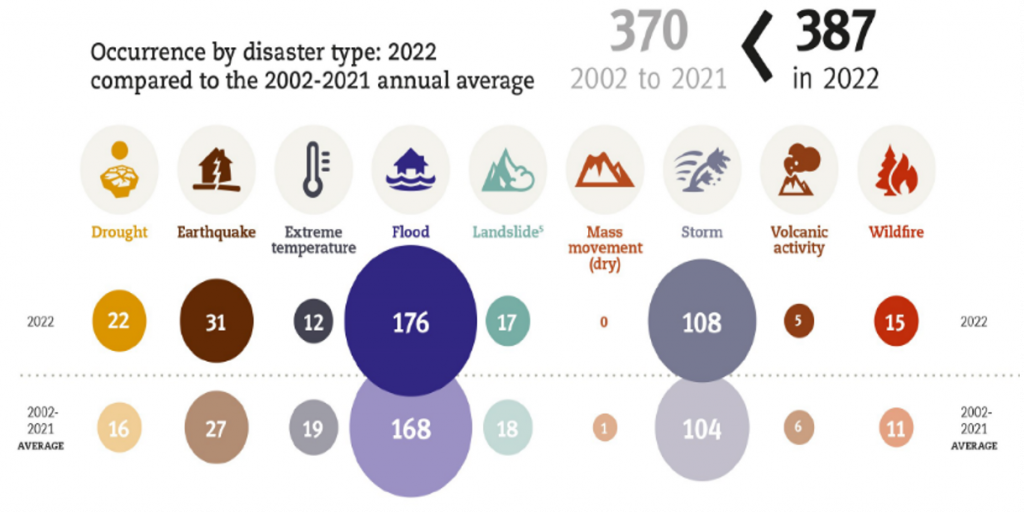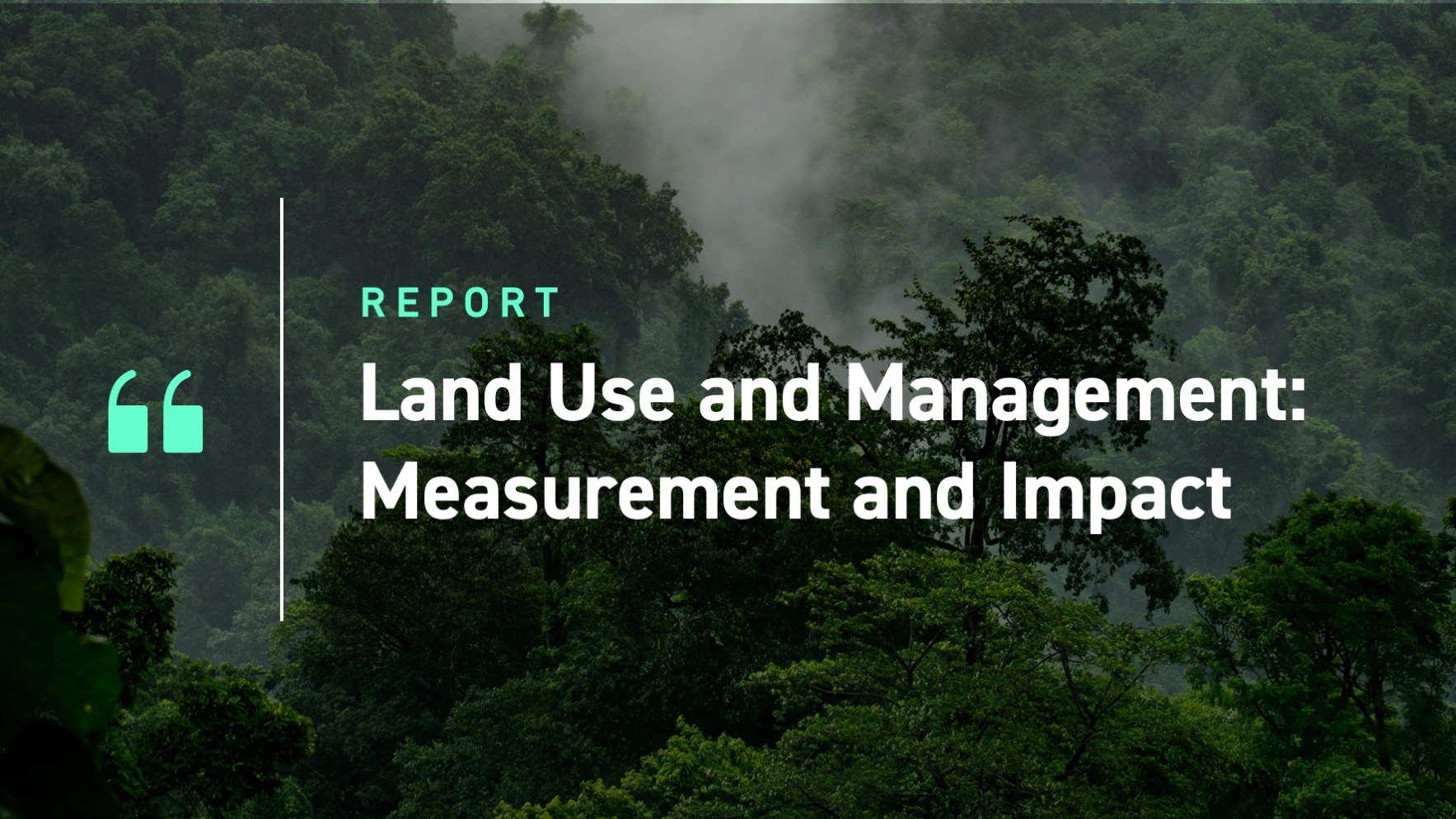Land Use and Management’s Impact on Key Environmental Risks
The two major environmental concerns dominating investor discussions today are climate change and biodiversity. The Stockholm Resilience Centre’s 9 Planetary Boundaries, the ‘natural’ limits within which humanity can survive and thrive, act as a reminder of the intricacies of both climate change and biodiversity, how they represent ‘interrelated processes within the complex biophysical Earth system’ and thus how each intrinsically impacts the other.
‘Climate Change’ is one of these planetary boundaries, and its global impacts on biodiversity, especially climate-related hazards, have increased both in terms of frequency and intensity. As of early October 2023, approximately one-third of 2023 had been 1.5°C higher than pre-industrial levels. Moreover, according to the international disasters database EM-DAT, the number of occurrences of floods, droughts, and wildfires in 2022 was greater than the average experienced over the previous 20 years (Figure 1). As a result, continued warming may well lead to a negative and potentially irreversible impact on biodiversity.
Figure 1: Climate Hazard Frequency, 2002-2021 vs 2022

Source: EM-DAT
Another planetary boundary that critically impacts both climate and biodiversity is ‘Land-System Change.’ However, there are different ways to actively limit these land-system changes, which currently contribute to higher GHG emissions. Limiting deforestation-related activities to reduce biodiversity loss, for instance, is also a key tool at humans’ disposal to decrease carbon emissions from the atmosphere. Implementing more sustainable agriculture practices, whether in relation to crops, livestock, or land management, is another one. But how can investors monitor and measure the impact of Land Use when looking to mitigate these key environmental risks?
Measuring the Impact of Land Use
Country Level: Land Use, Land Use Change, and Forestry (LULUCF)
Determining emissions resulting from Land Use, Land Use Change, and Forestry (LULUCF) (which technically excludes Agriculture but links to it) has been an area of contention for years, given its varied application. The IPCC, in its 6th Assessment Report (AR6), issued 20 years after its initial guidance on the subject, acknowledges that issues and knowledge gaps about contemporary emissions and sinks within LULUCF and Agriculture persist and that uncertainty remains high.
One primary challenge identified by the IPCC is the ‘alternative methodological approaches that incorporate different assumptions’ being used in agriculture, forestry, and land use. The IPCC also refers to the need to have more refined factors for calculating emissions from these activities, as well as better activity data and improved sharing of information regarding inventories and accounting.
Furthermore, including LULUCF emissions can lead to widely varying assessments of a country’s emissions profile. For example, LULUCF includes carbon sequestration, and accounting for such sequestration leads countries with large forests to likely experience a decline in emissions from those forests absorbing and storing carbon. Thus, accounting for LULUCF in Sweden would decrease the country’s emissions from approximately 47,800 kt CO2 to 6,100 kt CO2, which is less than the total emissions of Cyprus, a country with a GDP that is 6% of Sweden’s (Table 1).
Table 1: How LULUCF Impacts the Carbon Profile of Countries

Source: UNFCCC GHG Data Interface
The absence of agreed definitions or accounting methodology has made it a continuous challenge to include LULUCF in any kind of aggregated sovereign emissions reporting, despite LULUCF representing an important part of most countries’ Nationally Determined Contributions (‘NDCs’). To illustrate this importance, the EU alone has set a land-based net carbon removals target of 310 million tons of CO2 equivalent by 2030, almost 10% of its annual emissions. However, while Climate Action Tracker recognizes the importance of LULUCF, it continues to exclude it from countries’ targets and instead offers a separate analysis for it.
This approach is beginning to change, however. Recognizing LULUCF’s impact and role in sovereign decarbonization targets, the Partnership for Carbon Accounting Financials (PCAF) included in the December 2022 update of its Standard for Sovereign Debt not only the incorporation of new emission classifications (Scopes 1, 2, and 3) and the inclusion of Consumption emissions, but also a recommendation to report emissions both with and without LULUCF.
This step represented a substantial shift within the financial industry regarding what is considered ‘best practice’ when it comes to sovereign emissions, with LULUCF taking a more prominent place in risk monitoring.
In response, ISS ESG launched a newly expanded sovereign emissions dataset, which provides investors with the tools to assess continued alignment with PCAF recommendations, including a distinct metric for LULUCF emissions, as well as its 10-year trend.
Private-Sector Level: Agriculture, Forestry, and Other Land Use (AFOLU)
Beyond being a concern for countries, private-sector companies’ emissions from LULUCF are also subject to scrutiny. According to the IPCC, the Agriculture, Forestry and Other Land Use (AFOLU) sector may represent over 20% of global emissions, second only to the energy sector.
Recognizing the importance of addressing and supporting decarbonization in one of the highest-emitting sectors, the Science Based Targets initiative (SBTi) created specific guidance for companies with land-intensive activities, notably those involved in food, agriculture, and forestry: the SBTi Forest, Land, and Agriculture (FLAG) guidance. Figure 2 shows FLAG’s specific categories of land-intensive activities that can contribute to or mitigate carbon emissions.
Figure 2: FLAG Categories of Land-Intensive Activities That Impact Carbon Emissions

Source: SBTi FLAG
Since April 2023, all companies with land-intensive activities are required by the SBTi to include FLAG targets as part of their wider SBTi targets. The SBTi’s FLAG requires these companies to set near-term and long-term targets, with the long-term targets being in line with the SBTi Net Zero Standard. Companies are also expected to account for carbon removals by improving land management practices and to express a commitment to zero deforestation by 2025.
However, emissions accounting for the Land Sector has also lacked a market standard approach to date. Leveraging the work of the IPCC, REDD+, and others, the GHG Protocol began work in 2020 on guidance dedicated to the Land Sector to ensure greater consistency and transparency. Its corresponding Land Sector and Removals Guidance is expected to be published mid-2024.
Conclusion
Management of natural ecosystems, particularly land management, has a critical role to play in achieving not only biodiversity goals, but also the climate targets agreed to under the Paris Agreement. Its management may therefore be a vital consideration for investors across sovereign and corporate assets.
Accounting for LULUCF-related carbon emissions lends credibility to countries’ commitments to achieving their climate goals. Measuring LULUCF-related emissions also provides investors with an additional tool for holistically considering sovereign climate risk. Because of PCAF’s standard, assessments of sovereign climate risk will likely play a greater role in climate risk assessments going forward. The expansion of ISS ESG’s sovereign emissions dataset can support investors in tracking sovereign entities adherence’ to PCAF standards, including LULUCF.
On the corporate side, the number of companies with SBTi targets has more than doubled over the past 24 months. SBTi targets, a critical forward-looking metric for investors for several years already, have become a key area for investors to specifically monitor to ensure land-intensive companies are taking the necessary steps to align with a Net Zero future. The forthcoming GHG Protocol guidance for the Land Sector should also serve as a standard for measuring company performance on land management and carbon removal.
These metrics and the focus on Land Use can help investors connect the dots between climate and biodiversity issues. Addressing Land Use, along with the wider efforts to remain within the planetary boundaries, allows climate and biodiversity issues to be addressed and treated as one.
Explore ISS ESG solutions mentioned in this report:
- Use ISS ESG Climate Solutions to help you gain a better understanding of your exposure to climate-related risks and use the insights to safeguard your investment portfolios.
By: Nick Jeans, Head of Climate Analytics EMEA, Climate Solutions, ISS ESG
Soham Chakraborty, Climate Consultant, Climate Solutions, ISS ESG



